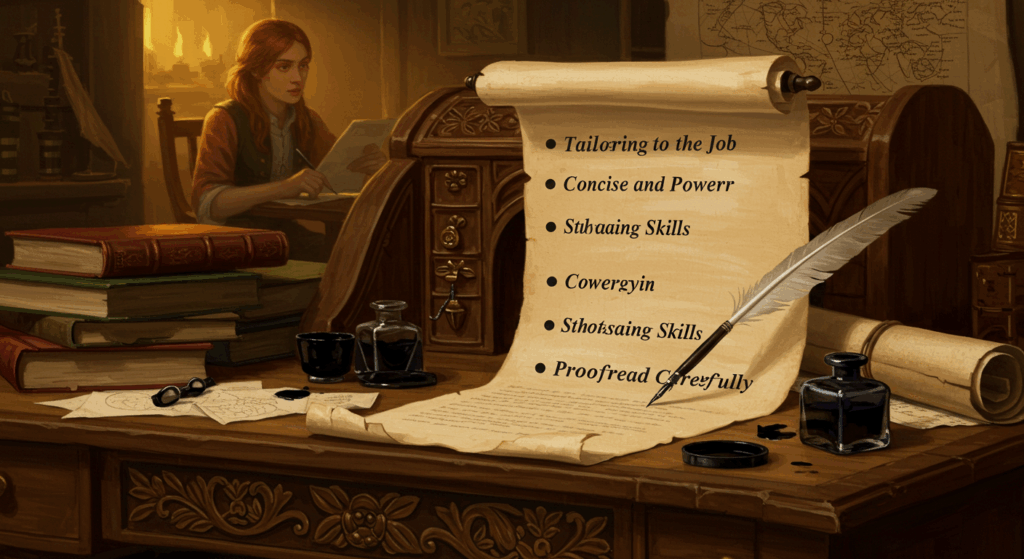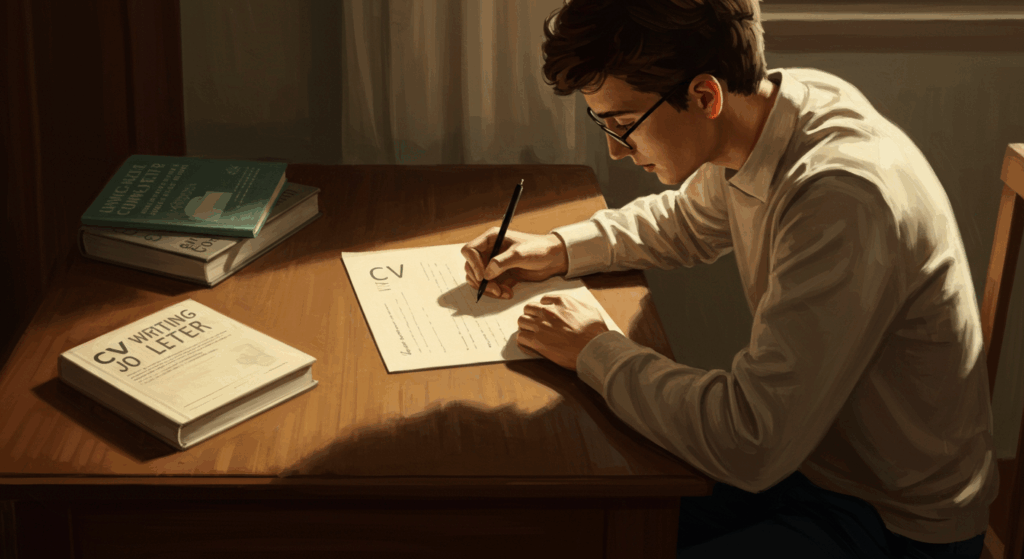Okay, so let’s talk about cover letters. Yeah, those awkward little essays we all try to dodge when applying for jobs. Like, isn’t the resume enough?? But nope—most companies still want that extra letter where you’re supposed to magically convince them you’re not just another applicant, but the one. Kinda feels like writing a dating profile, except instead of “I like long walks on the beach,” it’s “I have 3 years of project management experience and promise not to ghost you after onboarding.”
If you’re here, you’re probably staring at a blank Google Doc, wondering: how do I even write a cover letter that doesn’t sound like ChatGPT wrote it (oh, hi 👋) or like a copy-paste template that hiring managers roll their eyes at? Don’t stress. I got you. We’re gonna break this down in a way that’s actually doable and not soul-sucking. And yeah, I’ll sprinkle in some structure, examples, do’s and don’ts, so you can walk away feeling like you’ve got a solid plan.
Why Cover Letters Still Matter (ugh, unfortunately)
I know, I know. It feels old-school. Like CDs, fax machines, or trying to memorize pone numbers. But cover letters actually do matter more than you think. Some hiring managers legit use them as a tie-breaker. When two candidates look identical on paper, the letter shows who’s more thoughtful, who actually gets the company vibe, and who put in more effort than CTRL+C/CTRL+V.
Also, real talk? A good cover letter can save your butt if your resume isn’t stacked. Like maybe you don’t have 10 years of experience or a fancy Ivy League degree. The letter lets you explain your story—why you’re making a career switch, how you crushed it at an internship, or why you vibe with their mission.
The Structure: Don’t Overcomplicate It
Think of a cover letter like a TikTok video. People don’t want to sit through 10 minutes of fluff. They want you to get to the point, keep it engaging, and leave them with a reason to follow you. The structure doesn’t need to be rocket science:
- Header & Greeting: Your info, their info, and a “Dear [Hiring Manager’s Name].” If you can’t find their name, just say “Dear Hiring Team” (way better than “To Whom It May Concern,” which sounds like you wrote it with a quill in 1850).
- Opening Hook: Start strong. No “I’m writing to apply for…” snoozefest. Try a quick personal conmection or a bold statement.
- Middle Section (The Meat): This is where you flex—share 2–3 reasons you’re a good fit. Link your experience to the job description. Show, don’t tell.
- Closing Line: Wrap it up with enthusiasm, thank them, and drop a casual call-to-action like “I’d love to chat more about how I can bring value to your team.”
- Signature: Keep it clean. Name, email, LinkedIn link if you got one.
That’s it. Literally a one-page max. If you go over, it starts feeling like a manifesto.
Examples of Openings That Don’t Suck
Instead of:
“I am writing to apply for the Marketing Coordinator position at XYZ Company.”
Try:
“Scrolling through your company’s TikTok last week, I saw how you turned a boring product demo into a viral video. That’s the exact kind of creativity I’d love to bring to your team as a Marketing Coordinator.”
Or:
“As someone who once convinced my college club to triple event attendance with zero budget, I geeked out when I saw your posting for a Community Manager. Your mission to build authentic connections? I’m all in.”
See? Personality. Energy. Something human. Hiring managers read so many of these letters—they’ll remember the one that doesn’t sound like AI spit it out at 3 a.m.
The Do’s and Don’ts (aka how not to embarrass yourself)
Here’s the part where we lay out the obvious, but still worth saying. Cover letter do’s and don’ts, nice and simple:
Do’s
- Do research the company. Drop in a detail that shows you actually know who they are. Like, reference a recent project, campaign, or their mission.
- Do keep it personal. Hiring managers aren’t robots (at least not yet, lol). Write like you’re talking to a human.
- Do highlight value, not just skills. Don’t just list “I have X, Y, Z.” Show why those matter for the role.
- Do proofread. Typos happen, but triple-check. “I’d love to join your pubic relations team” is a different vibe.
Don’ts
- Don’t write a novel. One page. Tops. Nobody’s got time.
- Don’t make it all about you. Twist it back to how you’ll help them.
- Don’t use cliché buzzwords. “Hard worker,” “team player,” “self-starter”—yawn. Be specific instead.
- Don’t lie. Obvious, but yeah. People will find out.
Adding Your Personality Without Going Overboard
Here’s the tricky part: sounding human but still professional. You don’t wanna be overly stiff, but also not like you’re texting your bestie. The sweet spot? Professional with a dash of you.
Like if you’re applying to a fun, creative brand, maybe you drop a cheeky line:
“I’ve been called the Spotify DJ of my friend group (yes, even at 3 a.m.), and I bring that same energy to curating social media playlists for audiences.”
But if you’re writing to, say, a law firm, maybe tone it down a bit. Think “confident, clear, respectful,” but still avoid sounding like a robot.
How to Tailor Without Losing Your Mind
Okay, here’s the part everyone dreads: making a different cover letter for every job. I get it. It feels like homework times infinity. But tailoring doesn’t mean rewriting the whole thing from scratch.
Here’s my hack:
- Keep a base template. Write one solid version with your general story.
- Swap in specific details. Mention their company name, highlight a skill from the job possting, and maybe reference something unique about them.
- Adjust your hook. This is where you personalize the most.
Boom. You’ve got a letter that feels personal without eating up your entire Sunday.
Structure, Examples, Do’s and Don’ts Recap
So just to circle back—if you take nothing else from this, remember:
- Structure matters because it makes your letter easy to read. Header, hook, meat, closing, done.
- Examples are your best friend. Hiring managers want to see what you did, not just read adjectives about yourself.
- Do’s and don’ts keep you on track. Do add personality, don’t ramble. Do connect to the company, don’t copy-paste.
Keep those three in mind and you’re basically halfway there.
Sample Cover Letter
Your Name
[Your Address]
[City, State, ZIP]
[Your Email] | [Your Phone] | [LinkedIn link]
Date
Hiring Manager’s Name
[Company Name]
[Company Address]
Dear [Hiring Manager’s Name],
Scrolling through your company’s social media last week, I noticed how you turned a super technical feature into a fun, relatable campaign that actually made people stop and comment (rare these days). That’s exactly the type of creative energy I’d love to bring to your team as a Marketing Coordinator.
In my previous role at [Previous Company], I helped boost engagement by 45% in three months by experimenting with new content formats—think Instagram Reels before they were cool, and quirky polls that doubled our follower interactions. I also collaborated with cross-functional teams to design campaigns that weren’t just flashy but actuallly aligned with brand goals. Basically, I thrive at finding that sweet spot where strategy meets creativity.
Beyond the metrics, what excites me about [Company Name] is your mission to create authentic connections with your audience. It resonates with how I approach marketing: not just pushing content, but starting conversations and building community. I’d love the chance to apply that mindset (and a few of my weird-but-effective ideas) to help your team hit its next big growth milestones.
Thank you so much for taking the time to read this. I’d be thrilled to chat more about how my background in digital storytelling and campaign strategy could support [Company Name]’s vision.
Best,
[Your Name]
That’s one full page, clean and clear. Swap in the job title, your actual examples, and some specifics about the company you’re applying to—and you’re good.
Cover Letter Mistakes I’ve Totally Made (So You Don’t Have To)
Confession time: I once sent a cover letter to the wrong company. Yeah. I left in another company’s name and only realized after I hit submit. Cue the horror. So, lesson learned—always, always double-check the names.
Another one? I wrote one that was so generic it could’ve been for literally any job. Unsurprisingly, I never got a callback. Moral of the story: if your cover letter could be sent to five different jobs without changing a word, it’s probably not gonna land.
Wrapping It All Up
So, yeah. Writing a cover letter doesn’t have to feel like pulling teeth. If you think of it as telling your story—showing how your vibe + your skills match what the company needs—it actually gets kinda fun. Okay, maybe not fun fun, but like… satisfying when you hit that sweet spot.
Remember:
- Keep the structure simple.
- Show personality without going overboard.
- Use real examples that prove your value.
- Follow the do’s and don’ts like your life depends on it (okay, maybe not your life, but definitely your job prospects).
And honestly? Don’t overthink it. The best cover letters feel authentic, not perfect.
Now go write that thing. Put on your favorite playlist, grab some coffee (or boba, if you’re more of a boba person), and just start typing. You got this. And hey, that dream job? It might just be one good cover letter away.









